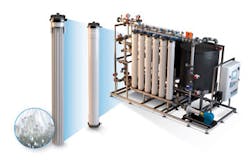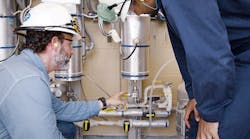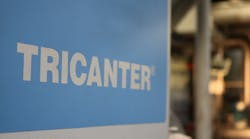Increasing attention is being paid to water-reuse technologies that pertain to the "next level" of difficult-to-treat or highly variable raw-water sources.
Recently introduced hollow-fiber ultrafiltration membrane technology is proving successful in reuse strategies applied to water sources that include high solids. The membranes can achieve higher recoveries for industrial water, work well for seawater pre-treatment and are even being used for potable water treatment.
One recent example is the PURON MP pressurized hollow fiber-ultrafiltration (UF) treatment system for high solids water and wastewater, developed and manufactured by Koch Membrane Systems (KMS).
The technology has achieved excellent results in 13 pilot tests around the globe, with full-scale systems under construction in China and Singapore. The membrane produces high-quality permeate at low fouling rates with difficult feed water. The design has a smaller footprint and we believe uses less energy and chemicals than other wastewater treatment options, offering lower lifecycle costs for difficult-to-treat water.
Global trends favor reuse
Governments around the world are shifting to water reuse strategies as population growth and global development places a strain on existing fresh water supplies. In addition, wastewater reuse in both industrial and municipal sectors is more prevalent as costs increase and regulations become more stringent for disposal. Treated wastewater effluent, on the other hand, can be used for agricultural and landscape or golf-course irrigation, industrial cooling processes and indirect potable reuse.
Water reuse strategies are taking hold around the U.S., with more systems coming online every day. In New York State watersheds, many wastewater plants use UF membrane filtration before discharging wastewater effluent to aquifers. In more arid environments that are experiencing water scarcity, like those in California, Arizona and Nevada, membrane plants are common. In some cases reclaimed water is distributed around a municipality for a variety of purposes through a completely separate water main, leading to increased overall water use efficiency.
As some sources of usable fresh water dry up or otherwise become unavailable, alternatives are becoming more attractive, including difficult-to-treat sources such as brackish water, pond water, or seawater. Ultrafiltration products are being developed to process the vast number of feed streams that are not clarified enough to be processed by drinking water membranes currently in place.
Surface waters –– like reservoirs, lakes and rivers –– can be highly variable in terms of suspended solids or turbidity. High solids and increased levels of total organic carbon (TOC) tend to wreak havoc on conventional water treatment equipment.
A storm rolling across a shallow lake can churn up sediment, causing a peak turbidity event. In a lake with an average turbidity of 5-10 NTU, a storm can cause a spike in turbidity levels to 100-200 NTU, or even as high as 1000 NTU. In the case of rivers, a two-inch rainfall can cause excessive runoff from roads to flow into the river. When this flow of this murky water enters a treatment plant using sand filter or clarifier technology, the plant often cannot meet set turbidity output standards.
Filtration challenges are increased by other factors as well, such as seasonal change, storm runoff, and water-temperature changes. Variability in suspended solids or turbidity is often introduced to water sources as seasons change. Finally, filtration is more difficult in colder water, as increased viscosity makes it more difficult to push water through a membrane filter.
Meet needs for permeate consistency
Ultrafiltration membranes development responds to the need for end-users to achieve consistent permeate under highly variable conditions. The PURON MP ultrafiltration membrane is for high-solids water and wastewater applications, including surface-water treatment, high TOC water treatment, RO pretreatment, and tertiary wastewater treatment. A combination of robust membrane fibers and a cartridge design allows it to withstand high-turbidity event stress with surprisingly effective flux recovery.
A four-year research and development process began with an early prototype placed at a reservoir test site with moderate-to-high TOC levels. This pilot, located near the KMS Wilmington, Massachusetts, manufacturing facility, ran for about 24 months. Researchers and engineers evaluated operating modes, cleaning sequences, and cartridge design. Tests were conducted on air scouring, back-flushing and chemical cleaning. The results were used to fine-tune the cleaning sequences.
Following positive test results, engineers developed and tested additional prototypes with different packing densities to arrive at the optimum number of fibers to place in each cartridge. The system has been tested on different applications at more than ten surface water or municipal wastewater pilot sites in the United States, Australia, China, Brazil, Italy and Spain. The tests have been used to optimize operating parameters and demonstrate long-term performance on a wide variety of feed water sources.
Full scale systems are currently being installed at industrial facilities in China and Singapore.
Pilot test shows high solids tolerance
Pilot testing indicates that the membranes can tolerate an extremely high level of solids even after significant storm events, producing consistent permeate no matter which type of raw water is received.
At one pilot site, the river providing feed water had periods of extremely high solids due to rains and runoff. Even with measured turbidity peaks up to 8000 NTU — while the pilot would see an increase in transmembrane pressure (TMP) — no unusual cleaning was necessary to return the cartridge to baseline TMP after the turbidity spike cleared. In general, even with these very high upsets, the permeate turbidity did not increase above 0.1 NTU.
At another site (see photo), the feed water consisted of high-fouling lagoon wastewater plant effluent with high TOC and incomplete nitrification. The change of season from fall to winter brought a snowfall that caused the lagoon to "flip," causing TOC readings to jump from 12-15 ppm to more than 20 ppm. Even so, the membrane cartridge consistently produced permeate with very low turbidity and silt density index (SDI) values, demonstrating excellent water reuse potential regardless of feed-water turbidity and TOC.
Operators back-flushed the pilot with a 20-minute cycle during the lagoon flip event, allowing the facility to stay clean without high TMP. The pilot operated well through the winter with very low temperatures and in high feed TOC conditions, at 25 gallons per square foot of membrane per day (GFD) with a clean in place (CIP) interval of 30 days. In addition, the unit demonstrated very high coagulant dosing tolerance.
Instead of dosing excessive, expensive concentrations to ensure that worst case conditions are managed, which is often the case in these type environments today, the tests with an on-line permeate UV254 instrument showed that coagulant dosage can be optimized for more efficient chemical consumption,
Figure 1 shows the flow through the membrane cartridge.
Reduced fiber sludging
The modules include features that make them more forgiving for use in difficult-to-treat waters and better able to handle high solids without fiber sludging. Because the cartridge makes use of a strong reinforced hollow fiber, the membranes are able to be bound or "potted" at the top end only. This single-potting design allows the membrane fibers to move freely within the cartridge, thereby allowing air scouring to penetrate the fiber bundle more completely and release accumulated solids to the bottom, where they are easily drained away.
In addition, backflush discharge is in the center of the cartridge, the zone most likely to experience sludging.
By contrast, other hollow-fiber membrane cartridges are designed for potting at both ends. The dual-head configuration restricts fiber movement, creating dead zones where solids accumulate. This fiber sludging reduces membrane surface area, system output and energy efficiency. Figure 2 shows a comparison between the two approaches.
The PURON MP system has automated cleaning sequences to keep the membrane clean during difficult turbidity events, eliminating the need to take down the system for intensive chemical cleaning. Air scouring, backflushing and draining keeps TMPs lower so operators do not have to come in on an emergency basis to deal with "events."
The cartridge uses virtually unbreakable braided, reinforced fiber, which minimizes any damage that could shut a system down or contaminate permeate. Results include improved uptime, ensuring the system can operate at full capacity, so there are no deleterious effects on downstream processes. Figure 3 shows the fibers, the cartridge and the complete skid.
High flux and solids tolerance properties eliminate the need for costly clarifiers and chemical pretreatments in many tough applications. This reduces the footprint required, limiting initial capital expenditure as well as operating costs associated with chemical use. Advanced membrane chemistry, a tight pore size & distribution and effective air-scouring deliver stable performance without extensive chemical cleans.
Conclusion
Recently developed, pressurized, hollow-fiber UF cartridge technology can produce high-quality permeate at low fouling rates with difficult feed water. Cartridge design incorporates a single header with free-floating, reinforced fibers that allow solids removal during cleaning. Simplified operation eliminates clarifier pretreatment in many applications, minimizes downtime, and reduces chemical usage. These benefits add up to a lower total cost of ownership.
Kevin Phillips is a product development manager with Koch Membrane Systems
For half a century, Koch Membrane Systems has been a developer of filtration membranes and a builder of custom and engineered systems for industries, with a worldwide installed base approaching 20,000 systems, that include industrial water and wastewater processing, dairy, juice and wine processing, industrial biotechnology and others. Its technologies reduce the water footprint and increase productivity.


